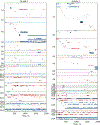Histone H4 Tails in Nucleosomes: a Fuzzy Interaction with DNA
- PMID: 33522067
- PMCID: PMC7994933
- DOI: 10.1002/anie.202012046
Histone H4 Tails in Nucleosomes: a Fuzzy Interaction with DNA
Abstract
The interaction of positively charged N-terminal histone tails with nucleosomal DNA plays an important role in chromatin assembly and regulation, modulating their susceptibility to post-translational modifications and recognition by chromatin-binding proteins. Here, we report residue-specific 15 N NMR relaxation rates for histone H4 tails in reconstituted nucleosomes. These data indicate that H4 tails are strongly dynamically disordered, albeit with reduced conformational flexibility compared to a free peptide with the same sequence. Remarkably, the NMR observables were successfully reproduced in a 2-μs MD trajectory of the nucleosome. This is an important step toward resolving an apparent inconsistency where prior simulations were generally at odds with experimental evidence on conformational dynamics of histone tails. Our findings indicate that histone H4 tails engage in a fuzzy interaction with nucleosomal DNA, underpinned by a variable pattern of short-lived salt bridges and hydrogen bonds, which persists at low ionic strength (0-100 mM NaCl).
Keywords: NMR spectroscopy; fuzzy protein-DNA interactions; histone tails; molecular dynamics; nucleosome.
© 2021 Wiley-VCH GmbH.
Conflict of interest statement
Conflict of interest
The authors declare no conflict of interest.
Supporting information and the ORCID identification number(s) for the author(s) of this article can be found under:
Figures



Similar articles
-
Conformational and Interaction Landscape of Histone H4 Tails in Nucleosomes Probed by Paramagnetic NMR Spectroscopy.J Am Chem Soc. 2023 Nov 22;145(46):25478-25485. doi: 10.1021/jacs.3c10340. Epub 2023 Nov 9. J Am Chem Soc. 2023. PMID: 37943892 Free PMC article.
-
Histone H3 and H4 tails play an important role in nucleosome phase separation.Biophys Chem. 2022 Apr;283:106767. doi: 10.1016/j.bpc.2022.106767. Epub 2022 Feb 2. Biophys Chem. 2022. PMID: 35158124 Free PMC article.
-
Histone H3 and H4 N-terminal tails in nucleosome arrays at cellular concentrations probed by magic angle spinning NMR spectroscopy.J Am Chem Soc. 2013 Oct 16;135(41):15278-81. doi: 10.1021/ja407526s. Epub 2013 Oct 7. J Am Chem Soc. 2013. PMID: 24088044 Free PMC article.
-
Breaths, Twists, and Turns of Atomistic Nucleosomes.J Mol Biol. 2021 Mar 19;433(6):166744. doi: 10.1016/j.jmb.2020.166744. Epub 2020 Dec 10. J Mol Biol. 2021. PMID: 33309853 Review.
-
Secondary structures of the core histone N-terminal tails: their role in regulating chromatin structure.Subcell Biochem. 2013;61:37-55. doi: 10.1007/978-94-007-4525-4_2. Subcell Biochem. 2013. PMID: 23150245 Review.
Cited by
-
DNA-Histone Cross-Link Formation via Hole Trapping in Nucleosome Core Particles.J Am Chem Soc. 2023 Nov 1;145(43):23702-23714. doi: 10.1021/jacs.3c08135. Epub 2023 Oct 19. J Am Chem Soc. 2023. PMID: 37856159 Free PMC article.
-
Redox signaling and skeletal muscle adaptation during aerobic exercise.iScience. 2024 Mar 29;27(5):109643. doi: 10.1016/j.isci.2024.109643. eCollection 2024 May 17. iScience. 2024. PMID: 38650987 Free PMC article. Review.
-
Molecular Mechanism of Nucleosome Recognition by the Pioneer Transcription Factor Sox.J Chem Inf Model. 2023 Jun 26;63(12):3839-3853. doi: 10.1021/acs.jcim.2c01520. Epub 2023 Jun 12. J Chem Inf Model. 2023. PMID: 37307148 Free PMC article.
-
Nucleosome conformation dictates the histone code.Elife. 2024 Feb 6;13:e78866. doi: 10.7554/eLife.78866. Elife. 2024. PMID: 38319148 Free PMC article.
-
Nucleosome composition regulates the histone H3 tail conformational ensemble and accessibility.Nucleic Acids Res. 2021 May 7;49(8):4750-4767. doi: 10.1093/nar/gkab246. Nucleic Acids Res. 2021. PMID: 33856458 Free PMC article.
References
-
- Cary PD, Crane-Robinson C, Bradbury EM, Dixon GH, Eur. J. Biochem 1982, 127, 137–143. - PubMed
-
- Weintraub H, Vanlente F, Proc. Natl. Acad. Sci. USA 1974, 71, 4249–4253; - PMC - PubMed
- Walker IO, Biochemistry 1984, 23, 5622–5628; - PubMed
- Hilliard PR, Smith RM, Rill RL, J. Biol. Chem 1986, 261, 5992–5998; - PubMed
- Stefanovsky VY, Dimitrov SI, Russanova VR, Angelov D, Pashev IG, Nucleic Acids Res 1989, 17, 10069–10081. - PMC - PubMed
Publication types
MeSH terms
Substances
Grants and funding
LinkOut - more resources
Full Text Sources
Other Literature Sources

